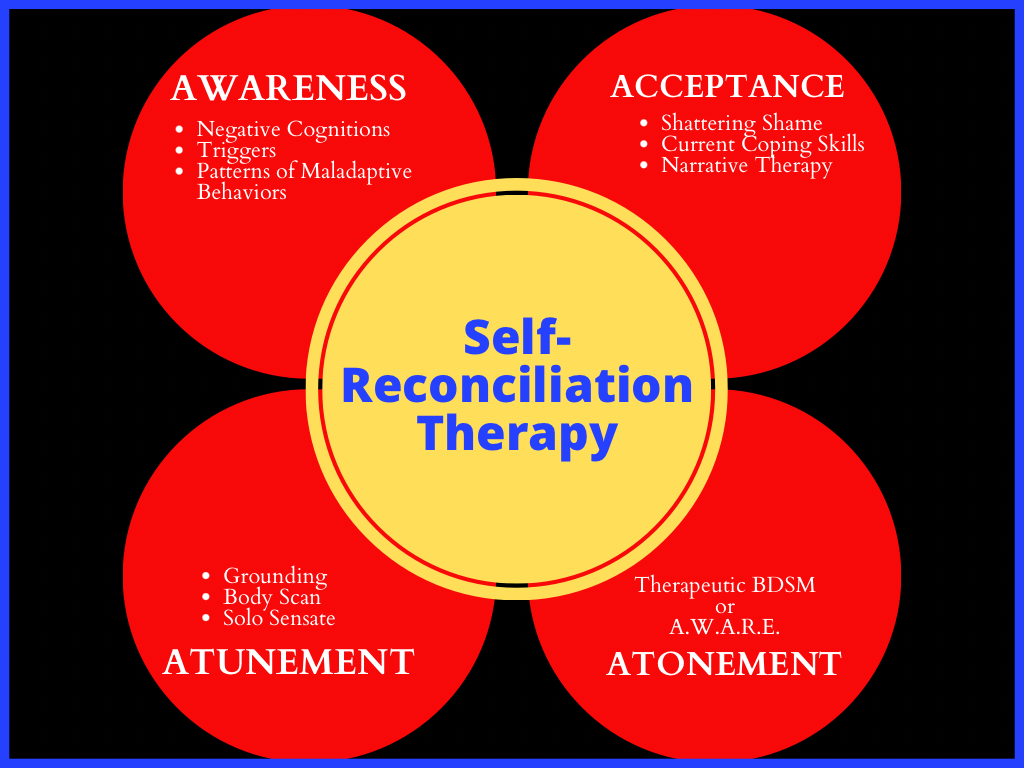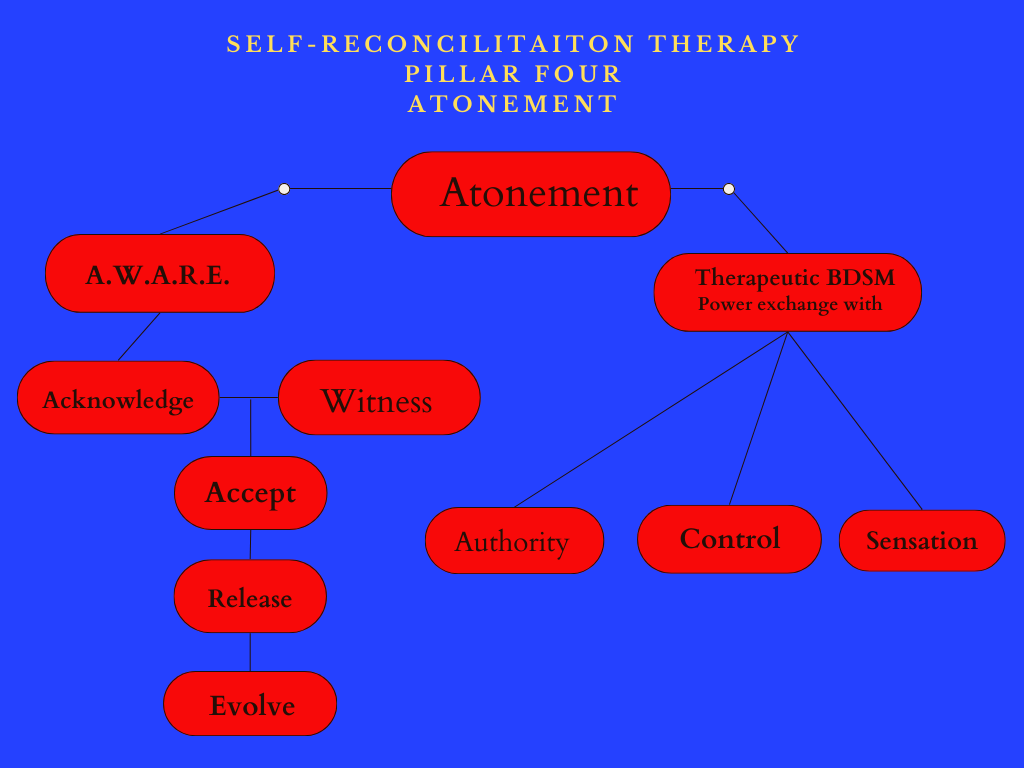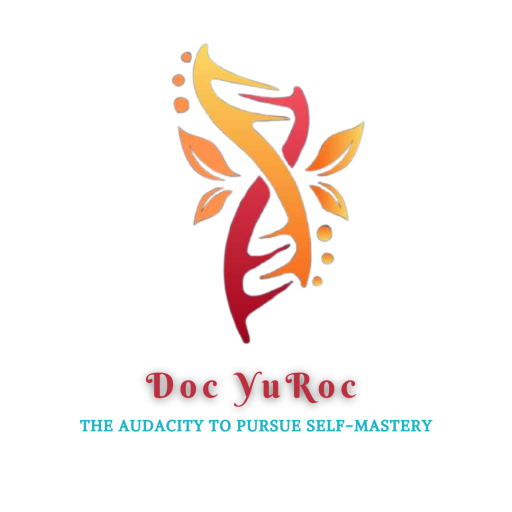SRT
Self-Reconciliation Therapy
Self-Reconciliation Therapy (SRT) is a therapeutic approach designed to help individuals process and integrate trauma that is stored or trapped in the body. It focuses on reconciling internal conflicts, particularly those that arise from trauma, by encouraging self-awareness, self-compassion, and emotional processing.
A therapeutic modality and technique that was originally created to specifically address the needs of Black women with a history of sexual trauma by taking into consideration their historical background and current lived experiences. The modality has since been expanded. “A Power Exchange with Your Pain: A Guide Towards Reconciliation with SELF!”
includes the therapeutic framework of SRT and includes the alternative healing intervention Therapeutic BDSM.
In conjunction with a historical foundation providing context for the need for collective healing for Black women, A Power Exchange… guides the individual toward self-reconciliation via education, contemplation, implementation, and an exploration of Therapeutic BDSM as an alternative healing method.
The Four Pillars of Self Reconciliation
Self-Reconciliation Therapy is a system of theories, techniques, and interventions creating a modality for optimal processing of trauma trapped in the body due to sexual abuse/assault.
A Power Exchange with Your Pain: A Guide Towards Reconciliation with SELF is a multipurpose reference collection of SRT techniques and therapeutic education. This book is a toolkit of clinical and non-clinical approaches to facilitate increased self-awarenss of triggers, patterns of maladaptive behaviors, and negative cognitions developed due to sexual trauma/abuse. In conjuction, SRT seeks to educate the reader via informational sections before each phase of the process, while also incorporating historical context delineating the need for the modality.
This book is meant to be a resource for clinician and client/reader as a metodology for trauma processing and healing.
The modality consists of four pillars that gradually deepens a persons self-understanding as they go from data collection to body integration.
Individuals have the opportunity to go on a solo, personal, and sacred journey of self-discovery by utilizing the guide as a form of self-healing or with the aid of an educated practitioner to provide support, which is highly recommended.
Each pillar consists of intentional curated assignments and exercises that build upon one another to aid the client/reader in acknowledging trauma, identifying patterns, integrating back into the body, and aligning with the divine within.
The four pillars are…
- Awareness
- Acceptance
- Attunement
- Atonement

Awareness
Awareness: knowledge or perception of a situation or fact; concern about and well-informed interest in a particular situation or development; the state of knowing something.
Self-Awareness: conscious knowledge of one’s own character, feelings, motives, and desires.

Acceptance
Acceptance (psychological): The process of not simply noticing but also embracing one’s experience without judgment or defense.
Self-acceptance is defined as “an individual’s acceptance of all of their attributes, positive or negative.”

Attune
Attune: to bring into harmony, to make aware or responsive.
Self-Attunement: to bring the mind, body, and spirit into harmony by being conscious of misalignment, the personal practice of bringing oneself into harmony.

Atonement
Atonement: the process by which people remove obstacles to their reconciliation with God (SELF).
Atonement (also atoning, to atone) is the concept of a person taking action to correct previous wrongdoing on their part, either through direct action to undo the consequences of that act, equivalent action to do good for others, or some other expression of feelings of remorse.
The Research
Self-Reconciliation Therapy was developed out of the research conducted and presented in the book “Healing The Angry Black Woman: The Research.”
SRT incorporates aspects of somatic experiencing, body mapping, and narrative therapy making it similar to some other forms of therapy.
What makes SRT different from other modalities/approaches is that it is predicated on the historical context of Black/African Americans with a history of sexual trauma, specifically Black/African American women to inform its development. It also uses a scaffolding process to break down the information into pieces that are digestible for implementation and processing.
SRT is NOT
-A cookie-cutter process lacking cultural context.
-Meant to be a short-term solution or a speedy process.
-Your regular “self-help” book lacking clinical, historical, and relevant cultural content.
Core Principles of Self-Reconciliation Therapy (SRT)
Somatic Processing
SRT emphasizes the connection between mind and body, recognizing that trauma is often stored in the body as physical sensations, tension, or dysregulation. Techniques in SRT aim to help clients identify and release this stored trauma through mindful awareness of bodily sensations.
Trauma-Informed
SRT is grounded in trauma-informed care, ensuring that clients are treated with an understanding of how trauma affects the brain, emotions, and body. It provides a safe space for clients to work through their trauma without re-traumatization.
Self-Acceptance and Compassion
One of the main goals of SRT is to help clients reconcile with themselves, often by fostering self-compassion. This involves accepting one’s emotions, behaviors, and trauma responses without judgment and understanding the roots of these feelings and reactions.
Rescripting and Reprocessing
In SRT, clients are guided through exercises and interventions that allow them to “rescript” their relationship with their trauma. This might involve revisiting past experiences in a controlled environment, often in collaboration with a clinician, to change the emotional narrative around the trauma and create new, more empowering associations.
Integration of Experience
A major focus of SRT is helping individuals integrate their traumatic experiences into a cohesive sense of self. This means that instead of the trauma causing fragmentation or disconnection, it becomes something that is acknowledged and understood as part of the individual’s story, leading to healing and wholeness.
Self-Regulation
SRT helps clients develop self-regulation skills, teaching them how to manage emotional distress, anxiety, or dysregulation that stems from trauma. These techniques help clients regain control over their responses to triggers and overwhelming emotions.
Application in Therapeutic BDSM
In the context of Therapeutic BDSM, SRT is used in scenes to help clients rescript their relationship with their trauma. Through carefully negotiated scenes with the guidance of a therapist and BDSM practitioner, clients can process stored trauma, experience a new narrative of power or release, and ultimately achieve self-reconciliation.
The Modality

Pillar Four: Two Paths- A.W.A.R.E. or "Therapeutic BDSM"

Pillar Four Atonement
Pillar four is the last pillar of the Self Reconciliation Modality leading to either Therapeutic BDSM which introduces the concept as an alternative healing method for those who wish to explore, or A.W.A.R.E., which is a deeper dive into the first two pillars of the modality encouraging increased self-awareness and an invitation to step onto the path of self-mastery.
Inviting and inspiring Healing….
#NoMoreSilo
Self Reconciliation Therapy was originally created as a modality by Dr. Yulinda Renee Rahman to meet the needs of Black women with a history of sexual trauma. The work has since expanded to include any individual with a history of body-based trauma. With that being said, Dr. Rahman still recognize the need to focus on the unique experience of the Black community so she created spaces that centers their stories, struggles, and strength.
No more silo is a movement where Black people as a collective are invited to heal in community. It is a call to shatter the belief that we must hide our pain and bear our burdens alone.
“Rarely, if ever are any of us healed in isolation. Healing is an act of communion” ~Bell Hooks~
Upcoming Events
Self Reconciliation Group Work
Pillar One: Awareness
May 6th, 2024 begins the six week journey through pillar one of the Self-Reconcilation Therapeutic Model.
Email to stay infomed.
Self Reconciliation Certification Training
August 2-4, 2024 from 9am -2pm Central
Three day certification training diving into the process of Self-Reconcilaition therapy, its creation to support clients with sexual trauma, the research, the interventions, and the implementation.
